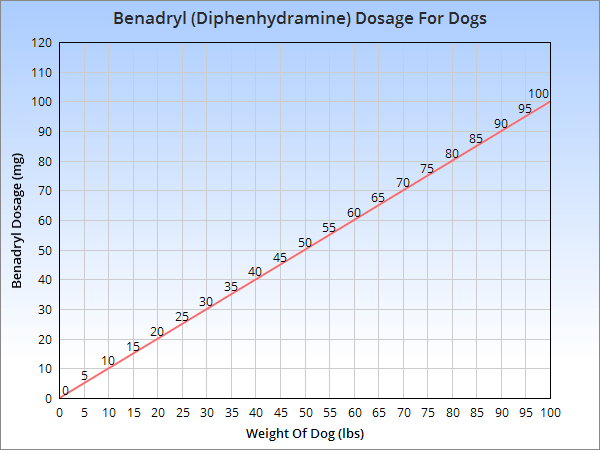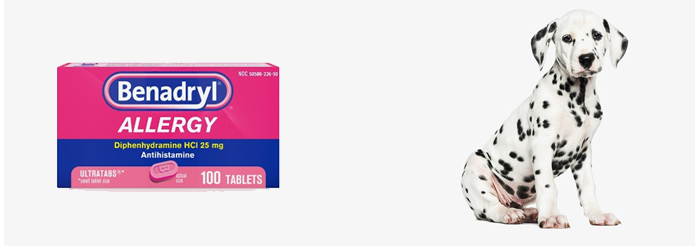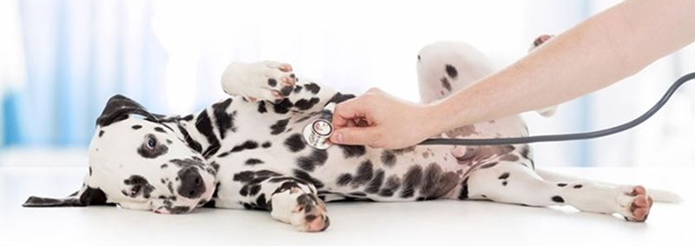Giving your dog medication often seems like a daunting task, mainly because it is. But you’re not alone in you attempt to ease your beloved dogs pain. Always speak with your vet first and use guides like this one as a handy reference.
What is Benadryl?
Benadryl, also known as Diphenhydramine, is an antihistamine, used for allergies in humans and dogs. Pet parents are often advised to give Benadryl to their furry best friends at home if they are suffering from allergies.
It is an easy to get, over-the–counter antihistamine that most times has no side effects. It helps alleviate motion sickness, combats all kinds of allergic reactions common to dogs like bug bite reactions, and anxiety or stress. There can be many benefits when using Benadryl for pets!
That said, there are a few important tips to remember before giving Fido this popular human antihistamine at home. Read on to learn all about them.
How much Benadryl to give a dog?
Sneak peek: 1 mg per lb. Administered 2 to 3 times per day.

Credit: Plumb’s Veterinary Drug Handbook
Dog owners across the nation who are adamant about using Benadryl for their dogs are faced with the ultimate question, “how much Benadryl can I give my dog?” Let’s find out what the experts say and what the studies show.
According to Dr. Jessica Vogelsang, DVM, PetMD “The standard dosage for oral Benadryl is 1 mg per pound of body weight, given 2-3 times a day. Most drug store diphenhydramine tablets are 25 mg, which is the size used for a 25-pound dog. Always double check the dosage before giving an over the counter medication. In addition, many formulations are combined with other medications such as Tylenol, so make sure Benadryl tablets contain only diphenhydramine.”
What the studies show
While Benadryl is geared towards human health, it should be only given under the supervision of your veterinarian. According to the Canadian Veterinary Journal, 2014, poisoning of animals occurs often.
“Medications, whether over-the-counter (OTC) or prescribed, contribute to companion animal fatalities; however, these poisoning events often result from accidental exposure due to ease of accessibility and lack of adequate supervision. There may be instances, though, whereby an owner symptomatically treats a pet with their own medication if they think the animal is unwell or in pain (e.g., paracetamol, ibuprofen, or naproxen), thus leading to an unintended consequence.” Dr. J. Buchweitz, Can. Vet. Ji.
Well absorbed in humans
According to the study diphenhydramine is well-absorbed in humans. Only 40% to 60% of this drug reaches the systematic circulation, with the drug first undergoing metabolism in the liver. While Benadryl’s use has not been studied in dogs, the study indicates that the parameters in humans with peak plasma concentrations of diphenhydramine occurs within 1 to 5 hours. Elimination of this drug occurs from 2.4 hours to 10 hours.
Recommended dosage for dogs
The study also mentions that the recommended therapeutic dose for dogs is 2 to 4mg/kg BW for allergy treatment or mild sedation before a stressful event. Additionally, for an 18kg dog, that would mean a dosage of 36-72 mg diphenhydramine or 1 to 1.5 tablets.
The research mentions that the margin of safety is narrow in this group of antihistamines, with dangerous effects occurring at or less than 1mg/kg above therapeutic doses.
The research demonstrates that 2 or more tablets can initiate potentially adverse effects. That said, oral doses of 1, 3, or 10 mg/kg BW have been known to have had no effect on a dog’s heart rate, mean blood pressure, or electrocardiogram in healthy dogs. The study also added that dogs given 10mg/kg BW of diphenhydramine were drowsier, and had non-REM movement sleep.
How to give your dog Benadryl?

Always consult with your vet prior to administering Benadryl. It has the potential to be deadly if used incorrectly! Steps to consider:
- Find out from your veterinarian as to the correct Benadryl dosage for your dog, according to:
- his weight
- medical history
- age
- and current medications.
- Try it out by giving a small amount to your dog to see if he has a reaction to Benadryl.
- You will need to wait a few hours to see if there are any side- effects.
- Add the correct dosage of Benadryl to your dog’s food with veterinary approval.
- If your veterinarian has recommended Benadryl in pill form, it can be broken up and added to your dog’s food.
- Liquid Benadryl can be added to your dog’s wet or dry food.
Things to keep in mind
Benadryl is available in numerous forms. Your veterinarian may prescribe it in either liquid or pill form. Since this drug is intended for human use, pet parents need to watch out for the following when purchasing Benadryl:
- Some forms of Benadryl combine both Benadryl and Cetirizine, which is another form of antihistamine. Do not give these medications to dogs.
- There is also a common combination of Benadryl, with Pseudoephedrine and Acetaminophen (Paracetamol). Both Pseudoephedrine and Acetaminophen (Paracetamol) are extremely dangerous to dogs.
- Always ask your veterinarian which type of Benadryl you should purchase for your dog.
- Read labels and instructions carefully.
- Call your veterinarian up if you have any questions.
- Time–released Benadryl capsules should not be used with dogs.
- Benadryl is a brand name with many different products sold under this name.
- Beware of generics that contain dangerous ingredients that are harmful to your dog.
Side effects of Benadryl for dogs

As much as we may like to help our dogs out by medicating them, Benadryl use should be strictly under veterinary guidelines. While many pet parents may think that Benadryl is a safe drug to use for dog anxiety issues during travel, as well as for use to resolve allergies and dog itch fast, an accurate Benadryl dosage according to your dog’s weight and medical condition is necessary.
Below are some side effects of Benadryl which caring pet owners are advised to avoid at all cost, and to lower the risk by educating themselves on the matter.
Benadryl poisoning in dogs
Dr. Buchweitz, DVM, explains that the most common symptoms that occur within 1 hour of incorrect dosing in living dogs are the following:
- Hyperactivity
- Depression
- Hyper salivation
- Tachypnea (rapid breathing)
- Tachycardia (rapid heart rate)
Benadryl overdose symptoms in dogs
- Mydriasis (pupil dilation)
- Dry mucous membranes
- Disorientation
- Fever
Recommended veterinary treatment for Benadryl overdose in dogs
Veterinarians will treat dogs that have overdosed on Benadryl with guaifenesin, and supportive fluid therapy. This results in a positive prognosis for recovery.
Lethal dose of Benadryl in dogs
“The lethal dose (LD50) for diphenhydramine in dogs ranges between 24 to 30 mg/kg BW by IV administration, and death has been attributed to neuromotor excitement and convulsions, followed by respiratory failure and myocardial depression.”
What dogs should avoid benadryl?
Although Benadryl is relatively safe, there are some dogs with medical conditions that should not take this antihistamine. Dogs that suffer from the following conditions:
- Allergic Lung disease
- Angle Closure glaucoma
- Bladder Neck Obstruction
- Bladder Disorders
- Heart Disease
- Enlarged Prostate
- High Blood Pressure
- Hyperthyroidism
- Sensitivity to diphenhydramine
- Pregnancy
- Prostatic Hypertrophy
- Seizure Disorders
- Vomiting (result of pylorus obstruction)
What drugs does Benadryl have an interaction with?
- Amitraz
- Central Nervous System Depressants
- Epinephrine
- Furazolidon
- Heparin Sodium or Calcium
- Selegiline
- Warfarin Sodium
Consult with your veterinarian if your dog is on any of the above medications. Benadryl may not be a good match because of a possible negative interaction. Antihistamines like Benadryl may enhance the effects of nonsteroidal anti-inflammatory drugs, corticosteroids, or fatty acid supplements.
They may necessitate for the dosages of the other medications to be lowered. Additionally, antihistamines like Benadryl cause drowsiness, and sometimes gastrointestinal problems. Overdoses and bad interactions with other medications can adversely affect the dog’s central nervous system, and ultimately result in death.
Another great read: Coconut Oil for Dogs – What You Should Know
What is Benadryl used for in dogs?
 Nowadays, it’s common knowledge that human medications should never be given to our furry best friends without a veterinary consult first. In fact, it could result in an overdose! That said, Benadryl use has increased among pet parents due to the many allergies that our dogs are suffering from today; along with a few other treatments Benadryl may offer dogs.
Nowadays, it’s common knowledge that human medications should never be given to our furry best friends without a veterinary consult first. In fact, it could result in an overdose! That said, Benadryl use has increased among pet parents due to the many allergies that our dogs are suffering from today; along with a few other treatments Benadryl may offer dogs.
Benadryl to treat anxiety in dogs
Stress in dogs is a common issue that pet parents face today. Dogs become stressed when left alone, for Fourth of July fireworks, during travel or changes in the home environment, and even during summer storms. That said, pet parents can also create a stressful environment for their dogs.
According to a study published in Applied Animal Behavior Science in 2016, dogs had premature grayness on their muzzle between 1 to 4 years of age due to being anxious. Noise anxiety (thunderstorms), separation anxiety, and social anxiety all affect domesticated dogs.
Symptoms
Dogs show anxiety in the following ways:
- Excessive barking
- Trembling
- Panting
- Excessive licking of body parts
- Shadowing pet parent
- Dogs may also display aggressive behavior, and destroy property
- Dogs may also injure themselves
- Urinating or defecating in the home when they have been housetrained
- Howling
- Trying to escape from home
- Hiding
Dogs that have not been socialized early on during puppyhood will display social anxiety when around other dogs and people. Dogs that travel by plane will also exhibit anxiousness. If your furry best friend displays any of these symptoms, it’s best to consult with your veterinarian and with an animal behaviorist before giving your dog Benadryl.
This antihistamine works to alleviate anxiousness by targeting the H1 histamine receptor in the brain. Benadryl works by relaxing an anxious dog, and making him lethargic. Additionally, Benadryl has anticholinergic properties that help prevent nausea during stressful events and travel. It also works as a muscle relaxant allowing for anxious dogs to feel more comfortable.
Benadryl to treat canine airborne allergies
Similar to humans, dogs can be allergic to various things, including dog food, plant particles, and allergens in the air. Allergens are substances that when inhaled, or absorbed through the dog’s skin, respiratory tract or gastrointestinal tract, cause inflammation.
That said, studies show that less than 10% of dogs are thought to be genetically predisposed to be sensitive to allergens in our homes. The onset of airborne allergies in dogs is thought to begin between the ages of 6 months and 3 years.
Symptoms of airborne allergies in dogs
- Itching of the face, feet, ears, front legs, and stomach area
- All over body scratching
- Secondary wounds which include scabbing, infection and hair loss
- Licking and chewing of paws, and rubbing face and eyes with paws
As always, it’s best to consult with your veterinarian if your dog is showing these symptoms. Allergy testing will most likely be recommended, along with a good management plan that has a few treatment options. Your veterinarian will prescribe anti-itch medication and antibiotics during the first phase of treatment. Benadryl use may be advised for seasonal flare-ups.
Benadryl to treat food allergies in dogs
Dog food allergies are less common in dogs than airborne allergies. Although the symptoms of dog food allergies are similar to those of airborne allergies, the intensity of the itching is the same in both cases.
Related: Hypoallergenic Dog Food Diets
Dogs can develop food allergies at any age. The only reliable way to check for food allergies is by eliminating certain food products, or by changing diets to a grain-free diet with a veterinarian’s recommendation. When switching dog food diets, it’s best to maintain a high-quality, balanced and nutritionally complete diet.
Dogs may be allergic to one specific ingredient. The food elimination diet trail will help confirm if a food allergy exists. Dogs are most often allergic to chicken, beef, corn, eggs, wheat, milk and soy products. Once your veterinarian has specified which ingredient is the offending allergen, he will recommend that this be avoided. Benadryl may be recommended to help lessen the symptoms of the food allergy.
Symptoms of dog food allergies
- Excessive itching
- Chronic ear inflammation
- Gastrointestinal problems
- Chronic diarrhea
- Chronic gas
- Licking feet
- Itchy rear end
Things to keep in mind
Benadryl can be used for dog food allergies, but under the strict guidance of a veterinarian. There can be times when a dog has an instant reaction to a dog food, and when the exposure to a food allergen can be deadly, with the onset of anaphylactic shock.
Dogs need to be taken to the emergency veterinarian right away when this happens. Always find out about the correct Benadryl dosage for your dog before any emergency situation occurs Be prepared!
In most cases of dog food allergies, the food allergy is extremely mild resulting in an itch. That said, it’s necessary to consult with your veterinarian. An antihistamine medication like Benadryl needs to be given under the strict guidelines of a veterinarian, so that the dosage is correct.
Additional uses of Benadryl as a treatment
Diphenhydramine can also be used to help dogs with mast cell tumors, who experience chronic inflammatory systems, caused from circulating histamine. Diphenhydramine also can be used as a sleep aid in dogs.
It causes drowsiness in dogs, and can be used as a mild tranquilizer. It works well in travel situations, since it prevents motion sickness, and relaxes dogs at the same time. Although drowsiness is not a desirable side effect, when it pertains to some forms of canine travel, it may be recommended by your veterinarian.
Final say on Benadryl for dogs

Whether it’s storm phobia, or food allergies, a good veterinarian and animal behaviorist can help you deal with these issues. Benadryl can help your furry best friend feel more relaxed during those thunderstorms, or holiday travel, yet as with any medication, Benadryl for dogs needs to be administered only after consulting with your veterinarian. Canine responses to antihistamines vary considerably.
As a pet parent, you will need to always discuss with your veterinarian any and all medications that you are giving your dog. As usual, it’s important to always read the label of all medications, and administer the correct dose as directed.
